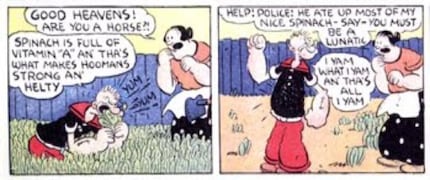
Background information
The health benefits of red fruit and veg
by Anna Sandner

You only need small amounts of it, but the effect on your body is huge - especially if you lack iron. What happens then, how you can cover your iron requirements and why Popeye only had to eat spinach all the time because of a comma error.
You only need around ten to 15 milligrams of iron per day and yet a deficiency is not that rare - due to monthly blood loss, especially in menstruating women.
Meeting your needs Popeye-style and eating lots of tinned spinach is not the solution, however: the idea that spinach is the ultimate source of iron is largely based on a decimal point error. When the iron value of spinach was determined in the 1930s, a decimal point slipped one decimal place to the right, so that the green vegetable was certified as having an iron content ten times higher than actually measured. This error was corrected in 1981 in the British Medical Journal. It also emerged that other measured values from that time were also distorted, as the measured spinach had been contaminated with iron through heating.
Not only does spinach contain significantly less iron than many believe, but the oxalic acid in spinach also inhibits iron absorption in the intestine. Nevertheless, the myth that spinach is a source of iron has stuck in many people's minds. Popeye, by the way, never bought into this misconception: According to the cartoon character himself, he eats spinach because of its high vitamin A content.

But back to the iron ...
Your body uses the majority of iron for the blood. More precisely: more than two thirds of the body's iron is incorporated into haemoglobin, a protein in our red blood cells. The main task of haemoglobin is to distribute oxygen from the lungs throughout the body and thus supply tissues and organs. If iron is missing, your body cannot carry out this vital process efficiently.
Iron is also an important component of many enzymes. Among other things, it is essential for the detoxification of medicines and supports our immune system. Iron is also required for the production of DNA, making the mineral indispensable for cell renewal.
This emergency reserve can be particularly important for menstruating women if a considerable amount of iron is lost during monthly bleeding.
If you lack iron, you feel weak and lacking in energy. The reason for this is that the iron deficiency means that not enough haemoglobin can be formed, resulting in anaemia. As a result, muscles, other tissues and organs can no longer be supplied with sufficient oxygen. It becomes more difficult to concentrate and it is not uncommon for headaches to occur. Torn corners of the mouth, brittle nails and hair can also be physical symptoms. This is because your body needs iron to build these structures.
Apart from fatigue, however, the symptoms usually only appear at a time when the iron deficiency has already been present for some time. As is so often the case, your body first tries to solve the problem itself by drawing on stored iron reserves. Between three and five grams of iron can be stored in the liver, spleen, bone marrow and muscles. Only when these stores are depleted will you notice the deficiency through symptoms. Fortunately, you can quickly remedy the situation with an iron-rich diet or, in the case of an acute deficiency, with dietary supplements. However, before you reach for iron supplements, a deficiency should definitely be medically diagnosed so that you don't jump from the frying pan into the fire: i.e. from a deficiency into an equally harmful oversupply.
Because the same applies to iron: the right amount is crucial. An oversupply of iron can harm your body. Increased blood transfusions can lead to an excess of iron or the genetic disease haemochromatosis, in which too much iron is absorbed in the intestine. The problem is that the excess iron is then deposited in a poorly soluble form in the organs, especially the liver, and disrupts their function.
The more likely case when something is imbalanced with the iron balance, however, is a deficiency of the mineral. However, it is easy to eat or drink to counteract this. As mentioned above, you don't have to eat kilos of spinach, but have a colourful selection of tasty iron sources to choose from:
The diagram shows that you don't necessarily have to rely on animal-based foods to get enough iron, as many plant-based products also contain high amounts of iron. However, it is important to note: Iron is found in animal products in a form that is easier for the body to absorb - haeme iron. In plants, on the other hand, it occurs as non-haeme iron. As this form of iron is bound to other compounds in food, it is more difficult for the body to absorb.
Three important tips:
As with everything, your individual iron requirements differ from average values. The reference value calculator from the German Nutrition Society provides more precise information than the generally applicable reference value. Here you can filter by gender and age, among other things, to get a better approximation of your actual requirements. The tool also covers other minerals, vitamins, energy-supplying nutrients and water.
Science editor and biologist. I love animals and am fascinated by plants, their abilities and everything you can do with them. That's why my favourite place is always the outdoors - somewhere in nature, preferably in my wild garden.
Interesting facts about products, behind-the-scenes looks at manufacturers and deep-dives on interesting people.
Show all